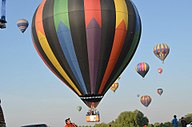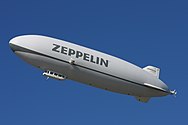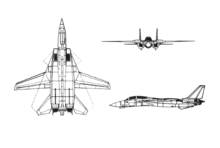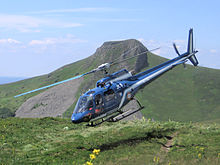Aircraft
An aircraft is any vehicle capable of navigating through the air or, in general, through the atmosphere of a planet. According to the ICAO, aircraft is "any machine that can move in the atmosphere by reactions of the air other than the reactions of the same against the surface of the earth".
It counteracts the force of gravity by using static lift or by using the dynamic lift of an airfoil or, in some cases, by the vertical thrust of jet engines. The most common examples of aircraft are airplanes, helicopters, airships, gliders, and hot air balloons.
Human activity surrounding aircraft is called aviation. The science of aviation, including the design and construction of aircraft, is called aeronautics. Crewed aircraft are flown by an onboard pilot, but UAVs can be remote controlled or self-controlled by onboard computers. Aircraft can be classified according to different criteria, such as type of lift, aircraft propulsion, use and others.
History
The history of aircraft and everything related to aviation goes back several centuries. However, the first manned ascent—with safe descent—in modern times was carried out with the largest hot air balloons developed during the century XVIII. On the other hand, each of the two world wars brought numerous and great technical advances for aviation and the development of aircraft. Consequently, aviation history could be divided into five key eras:
- Pioneros in aviation, from the first experiments with Leonardo da Vinci until 1914.
- First World War, 1914-1918.
- Aviation between world wars, 1918-1939.
- World War II, 1939-1945.
- It was from the post-war era, also known as the jet era, 1945 until today.
Types
The various types of aircraft existing today can be classified according to various criteria:
- Classification based on its principle of sustainability
- Classification based on their use
- Autonomy classification
- Sterling-based classification
- Classification according to external characteristics
- Classification according to landing surface
- Helicopter classification
- Unmanned aircraft
Classification based on its principle of support
Aircraft can be classified according to the physical principle that produces their lift (aerostats and aerodines):
Lighter than air
Aerostats
Aerostats are those aircraft that are lighter than air; They are characterized by using a fluid with a lower density than air, such as hydrogen or helium. They were the first to be developed, since their elevation principle made them much more affordable at the scientific and technological level of the time —XIXth century< /span>. Balloons rise according to Archimedes' principle. In this group are airships and hot air balloons.
Small hot air balloons, called sky lanterns, were first invented in ancient China before the 3rd century BCE. C. and were used mainly in cultural celebrations, and were only the second type of aircraft to fly, the first being kites that were first invented in ancient China over two thousand years ago. (See Han dynasty)
Hot air balloon
Hot air balloon: This is the name given to those balloons made up of a bag that contains a gas that is lighter than air and at the bottom of which there is a structure called a "nacelle" for the transport of passengers. They do not have any type of propulsion, so their movement follows the currents of air present at the moment. However, most of them do have a device to control the elevation.
A balloon was originally any aerostat, while the term airship was used for large, powered aircraft designs, usually fixed-wing.
In 1919, Frederick Handley Page was reported to be referring to "air ships," with smaller passenger types as "air yachts." In the 1930s, large intercontinental seaplanes were also sometimes called "ships of the air" or "flying boats". although none had yet been built. The advent of powered balloons, called "airship balloons," and later of rigid hulls that allowed for large increases in size, began to change the way these words were used. High-powered aerostats, characterized by a rigid outer frame and a separate aerodynamic skin surrounding the gasbags, were produced, with the Zeppelins being the largest and most famous. There were still no fixed-wing aircraft or non-rigid balloons large enough to be called airships, so "airship" it became synonymous with these aircraft. Later, various accidents, such as the Hindenburg airship disaster in 1937, led to the disappearance of these aircraft. Today, a "globe" it is an aerostat without an engine and an "airship" It's one with an engine.
Airship
Airships are propelled aerostats and have the ability to maneuver, therefore they can be controlled just like an aircraft. Although, like the previous one, they are also made up of a bag of gas that is lighter than air to achieve their lift.
Non-rigid airships are characterized by a moderately aerodynamic gasbag with stabilizer fins at the rear. These soon became known as airships. During World War II this shape was widely adopted for tethered balloons; In windy weather, this reduces stress on the leash and stabilizes the balloon. The nickname airship was adopted along with the shape. In modern times, any airship or small airship is called a blimp, although an airship may or may not be powered.
Heavier than air
Aerodynes are heavier-than-air aircraft. For their elevation they produce aerodynamic forces through supporting surfaces (wings). The development of this type of aircraft has meant that today there are such modern air vehicles. Lift can be generated by two methods, by fixed wings (fixed-wing aircraft) or rotary (rotary-wing aircraft).
This dynamic movement through the air is the origin of the term aerodyne. There are two ways to produce dynamic upward thrust: aerodynamic lift and "powered lift" in the form of engine thrust.
Aerodynamic lift involving wings is the most common, with fixed-wing aircraft held in the air by forward motion of the wings and helicopters by rotating wing-shaped rotors, sometimes called rotary wings. A wing is a flat, horizontal surface, usually shaped in cross section like an airfoil. In order to fly, air must flow over the wing and generate lift. A flexible brim is a brim made of cloth or thin sheet material, often stretched over a rigid frame. A kite is tied to the ground and depends on the speed of the wind on its wings, which can be flexible or rigid, fixed or rotating.
With powered lift, the aircraft directs engine thrust vertically downward. V/STOL aircraft such as the Harrier Jump Jet and Lockheed Martin F-35B, take off and land vertically using powered lift and transfer to aerodynamic lift in constant flight.
A pure rocket is not usually considered an aerodyne because it does not depend on air for lift (and can even fly into space); however, many aerodynamic lift vehicles have been powered or assisted by rocket engines. Rocket-propelled missiles that gain aerodynamic lift at very high speed due to airflow over their bodies are a marginal case.
Fixed Wing
Are those aerodynes in which the wings are attached or embedded with the rest of the elements of the aircraft, and do not have their own movement. It should be noted that within this category, aircraft with variable geometry wings are also accepted. This type of design is aimed at better adaptation to subsonic-supersonic flight regimes.
The precursor to fixed-wing aircraft is the kite. While a fixed-wing aircraft relies on its forward speed to create airflow over the wings, a kite is tethered to the ground and relies on the wind blowing over its wings to provide lift. Kites were the first type of aircraft to be flown and were invented in China around 500 BC. C. Much aerodynamic research with kites was done before test planes, wind tunnels, and computer modeling programs were available.
The first heavier-than-air ships capable of controlled free flight were the Pentes. A glider designed by George Cayley made the first truly manned controlled flight in 1853.
Fixed-wing aircraft include
- Aeroplanes
- Planners/velopers,
- Ala deltas,
- Paragliding,
- Paramotors and
- Ultralighters:
Airplane
Aeroplanes are heavier-than-air aircraft, provided with wings and a body capable of flight, always propelled by one or more engines.
- Planners/Veleros: they are unmotorized aerodynos. Its support and transfer forces come only from the aerodynamic general result.
- Ala delta: is an aerodyne composed of a very wide fabric surface in the form of delta supported by a structure of a light material in whose center the pilot is suspended. Its operation is based on the use of the rising air currents.
- Paragliding: This is a glittering aerode consisting of a flexible wing that does not have rigid parts. The pilot is located in a chair or harness that is located under the wing and attached to it by strings and carabiners.
- Paramotor: it is a paraglider that has a motor in the back of the driver's seat/bark.
- Ultralight: they are light aerodynes and with little fuel consumption that have a maximum of two places, aimed at carrying out economic leisure flights.
Rotary Wing
Are those aerodynes in which the wings, in this case also called "blades", rotate around an axis, thus achieving lift. The following aircraft are included in this category: gyros, helicopters, combinations, and convertibles.
- Helicopter: rotating wing aircraft in which the rotor is driven by an engine and is articulated in such a way that it produces sustenance and propulsion. By leaning the rotor forward, the downstream bends back, producing push for the flight forward. Some helicopters have more than one rotor and some have rotors rotated by gas jets at the tips.
- Autogiro: rotating wing aircraft whose rotor rotates as a result of the aircraft's displacement and generates support without having to apply power over it. However, you need a tractor propeller to make the horizontal forward flight. You can't fly to a fixed point, but the minimum speeds you can reach are very low.
- Girodino: rotating wing aircraft with auxiliary elements for advancement. Basically it is a helicopter with a tractor propeller to increase the advance force.
- Convertible: Rotary wing aircraft in which the propeller- rotor sets change their attitude 90 degrees with respect to fuselage, acting as rotators in helicopter mode and as propellers in fixed wing aircraft mode.
- Cyclogiro: Cyclogiro, or cyclopter, is an aircraft configuration that uses a horizontal axis cyclotor as a rotor wing to provide sustainability and sometimes also propulsion and control. In principle, the cyclopter is capable of taking off and landing vertically and flying as a helicopter, while potentially benefiting from some of the advantages of a fixed wing aircraft. Cyclogiro is different from the Flettner plane that uses a cylindrical wing rotor to take advantage of the Magnus effect.
Space rockets can be considered a particular type of aircraft as they travel through the interior of Earth's atmosphere, and are designed with this segment of flight in mind.
Other lifting methods
- A supportive fuselage is an aircraft body shaped to produce sustainability. If there are wings, they are too small to provide significant support and are only used for stability and control. The lifting bodies are not efficient: they suffer from a great aerodynamic resistance and, moreover, they must move at high speed to generate sufficient support to fly. Many of the research prototypes, such as the Martin Marietta X-24, which led to the Space Shuttle, were lifting bodies, although the Space Shuttle is not, and some supersonic missiles get the support of the air flow over a tubular body.
- Types of motorized lift they are based on the motor lifting for takeoff and vertical landing (VTOL). Most types make a transition to fixed wing elevation for horizontal flight. Motorized lift types include VTOL (such as Harrier Jump Jet) and tiltrotor aircraft, such as Bell Boeing V-22 Osprey, among others. A few experimental designs are fully based on the engine thrust to provide support throughout the flight, including personal floating platforms with fan and jetpacks. Among the VTOL research designs is the Rolls-Royce Thrust Measuring Rig.
- The Flettner plane uses a rotary cylinder instead of a fixed wing, obtaining the support of the Magnus effect.
- The ornitóptero get the push by beating the wings.
Classification by sizes and speeds
Sizes
- The largest aircraft by size and volume (to date 2016) is the British Airlander 10, 92 m long, a hybrid airship, with helicopter features and fixed wings, and allegedly capable of reaching speeds up to 90 mph (140 km/h; 78 kn), and a two-week air autonomy with a payload of up to 22 050 lb (10 000 kg).
- The largest plane per weight and the largest fixed wing regular plane ever built in 2016 is the Antonov An-225 Mriya. This Russian transport of six engines, built in Ukraine in the 1980s, has 84 m in length and a size of 88 m. It has the world record of payload, after transporting 194 516 kg (428 834 lb) of goods, and has recently commercially flown loads of 100 t (220 000 lb). With a maximum load weight of 550-700 t (1 210 000-1 540 000 lb), it is also the heavier plane built to date. It can reach a cruise speed of 800 km/h (430 knots).
- The largest military aircraft are the Ukrainian/Russian Antonov An-124 Ruslan (the second largest aircraft in the world, also used as civilian transport), and the U.S. transportation Lockheed C-5 Galaxy, which weighs over 380 t (840 000 lb). The Hughes H-4 Hercules "Spruce Goose" of 8 engines and piston/herit, an American transport of wooden flying ships of the Second World War with a larger size (94 m/260 feet) than any current plane and a tail height equal to that of the highest (Airbus A380-800 with 24.1 m/78 feet)- flew out of the 1940s and never flew.
- The largest civilian planes, apart from the aforementioned An-225 and An-124, are the Airbus Beluga, derived from the Airbus A300 passenger plane, the Boeing Dreamlifter, derived from the Boemboing 747 passengers plane (the 747-200B was, at the time, the heaviest plane ever built) and the Airbus A380, the "superjumbo" of two floors, (the 747-200B was more passengers
Speeds
The fastest recorded flight of an air-powered aircraft was by NASA's NASA X-43 A Pegasus, an experimental hypersonic research aircraft with lifting body and scramjet propulsion, at Mach 9.6, exactly 3292.8 m/s (11,854 km/h; 6,400.7 kn; 7,366 mph). The X-43A set that new mark and broke its own world record of Mach 6.3, exactly 2,160.9 m/s (7,779 km/h; 4,200.5 kn; 4,834 mph), set in March 2004, at its third and last flight on November 16, 2004.
Prior to the X-43A, the fastest recorded flight of a powered aircraft (and still the record for fastest manned aircraft / fastest manned aircraft other than spacecraft) was that of the American North American X-15, rocket-propelled aircraft at Mach 6.72, or 2,304.96 m/s (8,297.9 km/h; 4,480.48 kn; 5,156.0 mph), on October 3, 1967. In one flight it reached an altitude of 354,300 ft (108,000 m).
The fastest known production aircraft (other than rockets and missiles) currently or previously in operation (as of 2016) are:
- The fastest fixed wing plane and the fastest glider is the Space Shuttle a rocket-planner hybrid, which has reentered the atmosphere as a fixed wing planner to more than Mach 25, equivalent to 8575 m/s (30 870 km/h; 16 668 knots; 19 180 mph).
- The fastest-built military aircraft ever built: The Lockheed SR-71 Blackbird, a fixed-wing American reconnaissance aircraft, known to fly beyond Mach 3.3, equivalent to 1131.9 m/s (4075 km/h; 2200.2 kn; 2532 mph). On 28 July 1976, a SR-71 established the fastest and highest operating plane record with an absolute speed record of 3529 km/h (2193 mph; 1906 kn; 980 m/s) and an absolute altitude record of 25 929 m (85 068 ft). At the time of its withdrawal, in January 1990, it was the fastest reaction plane in the world, a record that remains in effect in August 2016.
- Note: Some sources refer to the above-mentioned X-15 as the "fastest military aircraft" because it was partly a Navy and U.S. Air Force project; however, the X-15 was not used in actual non-experimental military operations.
- The fastest current military aircraft are the Soviet Mikoyan-Gurevich MiG-25, capable of reaching Mach 3,2, equivalent to 1097.6 m/s (3951 km/h; 2133. 6 kn; 2455 mph), at the expense of engine damage, or Mach 2.83, equal to 970.69 m/s (349.5 km/h; 1886.87 kn; normally 2171.4 m/s Both are hunting-interceptor planes, in active operations from 2016
- The fastest civilian plane ever built, and the fastest passenger plane ever built: the supersonic Tupolev Tu-144, briefly operated (Mach 2,35, 1,600 mph, 2,587 km/h), which is believed to reach a cruise speed of approximately Mach 2,2. The Tu-144 (officially operated from 1968 to 1978, and which ended after two accidents of the small fleet) was overcome by its rival, the Concorde (Mach 2,23), a French/British supersonic passenger plane, of which it is known that it reaches a speed of cruise of 2,02 Mach (2,333 kmh at cruise altitude), and that operated from 1976 until the small fleet of Concorde was finally on the ground in 2003,
- The fastest civilian plane currently flying: the Cessna Citation X, an American business plane, capable of reaching Mach 0.935, or 320.705 m/s (1.154.54 km/h; 623.401 kn; 717.40 mph). Its rival, the U.S. Gulfstream G650, can reach Mach 0.925, or 317,275 m/s (1,142.19 km/h; 616.733 kn; 709,72 mph)[26][40][41].
- The fastest passenger plane currently flying is the Boeing 747, which is attributed to a cruise speed greater than Mach 0,885, 303,555 m/s (1.092,80 km/h; 590,064 kn; 679.03 mph). Previously, the fastest were the problematic and ephemeral Tupolev Tu-144 SST Russian (Soviet Union) (Mach 2,35; equal to 806,05 m/s (2,901.8 km/h; 1,566,84 kn; 1,803.1 mph) and the French/British Concorde, with a maximum speed of Mach 23 or 686 m/s (2,470 km/h; 1,333 k Before them, the Convair 990 Passenger Aircraft from the 1960s flew over 600 mph (970 km/h; 520 kn; 270 m/s).
Classification based on use
Today, aircraft can also be grouped according to their scope of application: civil or military.
Once this sieve has been passed, several subcategories can be differentiated to specify and describe their use function in more detail.
Military aircraft
The purpose of these aircraft covers both attack, defense, reconnaissance and surveillance, transport, rescue and similar flights. However, considering the specific mission for which they were designed, military-type aircraft can be classified into combat aircraft and military transport and logistics support aircraft.
Combat Aircraft
This is the name given to aircraft oriented specifically for war purposes. They can be categorized based on the type of mission they perform.
- Hunting-intercepting aircraft: Designed, equipped and armed for use in the search and destruction of enemy aircraft, as well as for the defence of their own airspace. They have the ability to employ low-size tracks as well as a great maneuverability and speed.
- Cazabombarcadero: Fighter aircraft prepared to use indistinctly air-to-air weapons and air-to-ground or air-to-mar armaments. This is suitable for both air defence and ground attack platform. Today, it is the most widely used type of combat aircraft worldwide as a very flexible weapons system with multi-mission capacity.
- Bomber: Designed to transport a fixed load type and throw it on the Earth target. They are composed of wineries and anchor points to transport the armament. According to their transport capacity, they can be classified in light, medium and heavy or on the other hand depending on their level of threat, conventional or strategic.
Transport and logistic support aircraft
This designates military aircraft that are not specifically combat-oriented, performing other tasks of military interest. Included within these are those oriented towards transportation, in-flight refueling, surveillance of airspace and maritime space, electronic warfare, training, etc.
Civilian aircraft
Includes all aircraft whose use is aimed at the civil sphere, whether commercial or general. In the same way that the military can be grouped according to their purpose of use. The following categories are distinguished: commercial aircraft and training/leisure aircraft.
Commercial aircraft: This category includes aircraft used by airlines to transport cargo and passengers, whether for use on regular flights, charter, etc. In the case of those of the passenger transport type, they can be divided into several groups based on their physical characteristics.
- Wide fuselage: This category includes larger passenger transport aircraft, used for long-haul flights (e.g.: transoceanic). In most cases in these aircraft, the passenger cabin consists of two corridors for the transit of people. It can be seen at Boeing 747, Airbus A340, Airbus A380, Lockheed L-1011 TriStar...
- Straight fuselage aeronave: These aircraft are smaller and therefore less autonomy. Destined for mid-range flights, they have less capacity to transport passengers. Example of them are Boeing 737, Airbus A320...
- Regional Aeronave: These aircraft usually have a maximum transport capacity of 100 passengers and are used for short-short regional flights. In this case you can see a greater variety of design, with turbofan engines or turbohélice. See Embraer ERJ 145 series, Bombardier CRJ700/900/1000, saab 340...
- Aircraft communer: These aircraft, designed mainly for short-range flights, depending on their size, motorization and seat configuration, are called "communer» or «air taxis». These aircraft are generally not subject to regulations applicable to larger passenger transport aircraft. The cabin design is very different from that of the latter and is generally customized to the customer's taste. Embraer EMB 110 Bandeirante, jetstream 31, aircraft of some Cessna series...
- Training/ocio aircraft: They are aircraft geared towards the formation of pilots and the realization of flights as a leisure activity. They are light aircraft, with at least two seats, one for the flight instructor and another for the pupil in the case of instruction aircraft or for the client if it is recreational. Within this category we can also include aircraft for acrobatics or fumigation. Piper PA-28 Cherokee, Mooney M20, Cessna 172...
Experimentals
An experimental aircraft is one that has not been fully flight tested, or that carries a Special Certificate of Airworthiness called an Experimental Certificate in the language of the United States. This often implies that the aircraft is testing new aerospace technologies, although the term also refers to kit and hobbyist-built aircraft, many of which are based on proven designs.
Models
A model airplane is a type of very small unmanned aircraft made to be flown for fun, for static display, for aerodynamic research, or for other purposes. A scale model is a replica of a larger design.
ICAO Aircraft Type Designator
According to what is established in ICAO document 8643/29, certain dimensional, technical or engineering criteria must be followed when classifying aircraft. This provides, as this is the organization par excellence for aviation, a reliable, uniform and global classification method.
This document contains the designators of those types of aircraft that are most commonly provided with air traffic service (ATS).
The document is made up of four parts, where the list of aircraft manufacturers is specified, the list of aircraft types by type designator in alphanumeric order, the list of aircraft types by model number and/or name of the model and finally, the list of aircraft manufacturers by their current trade name.
When formulating aircraft type designators, ICAO is governed by some basic principles that we can see in the aforementioned document. However, for the aircraft type description, three characters will be used.
The first character
L - Land Plane
S - Seaplane
A - Amphibian
H - Helicopter
G - Gyrocopter
T - Tilt-wing aircraft
Second character
1,2,3,4,5,6,8 o C - number of engines. (The character C applies to fixed-wing aircraft only and indicates that two engines are coupled to drive a single propeller system.)
Third character
P - piston engine
T - turboprop/turboshaft engine
J - jet engine
E - electric motor
Contenido relacionado
King's Cross Station
Cx
Annex: Manned missions to space by program













